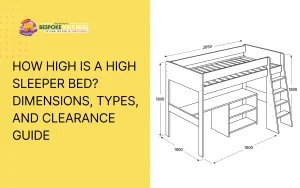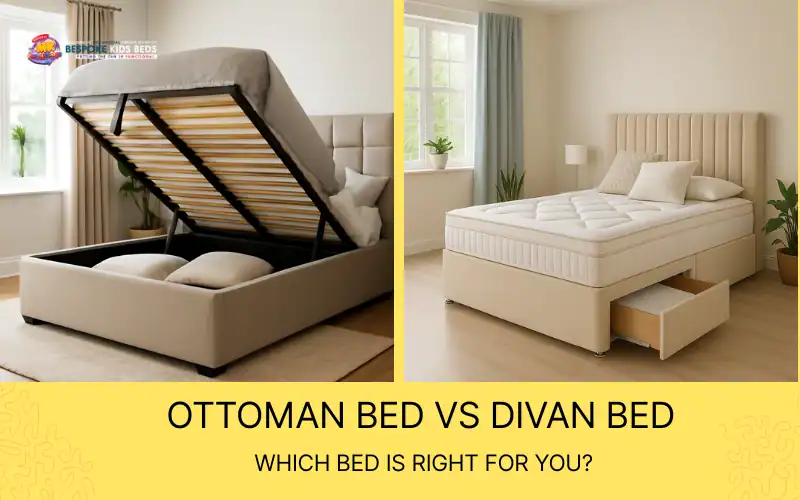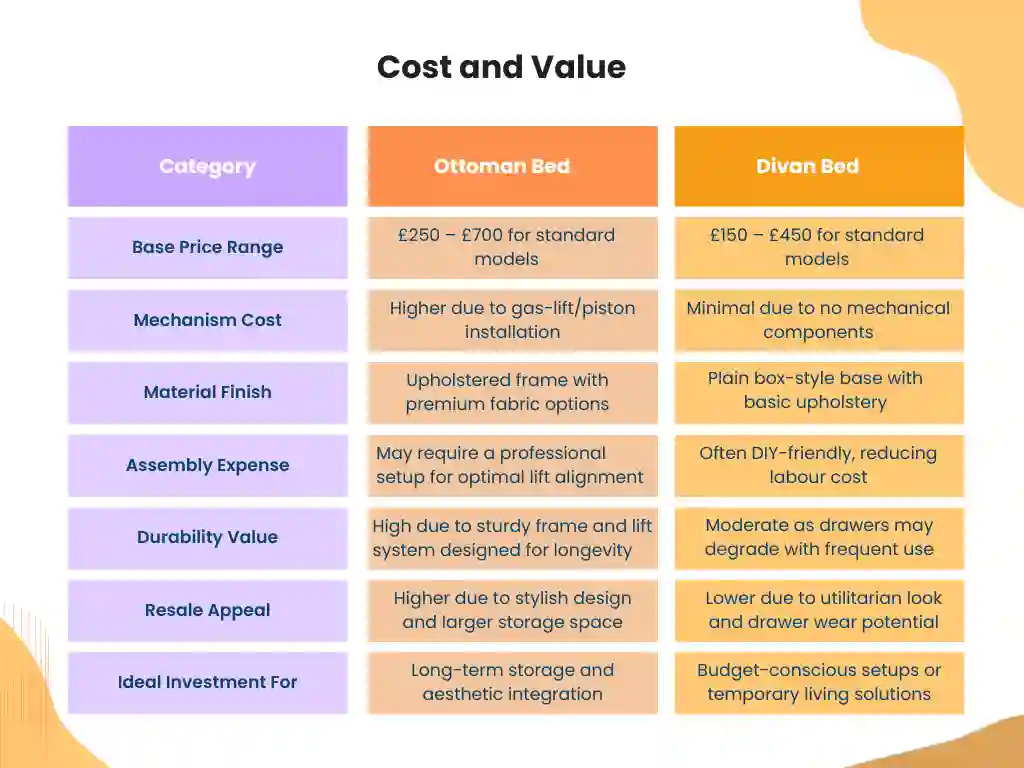
How High Is a High Sleeper Bed?
A high sleeper bed measures between 170 cm and 200 cm in total height, depending on the model and design. These beds create usable space
Enjoy FREE Delivery on All Orders!

Ottoman beds provide deeper, hidden storage while divan beds offer easier, drawer-based access for everyday use. Although both are considered storage beds, their functionality, accessibility, and design suit different room layouts and lifestyle needs.
The core distinction lies in how each bed stores items. Ottoman beds lift the entire mattress base with the help of a gas-lift or piston system, revealing a spacious, uninterrupted storage compartment. This setup is ideal for storing bulky or seasonal items that are not needed daily. In contrast, divan beds feature built-in drawers on one or both sides of the base, enabling convenient, segmented access to smaller items like linens or clothing.
This guide walks you through a side-by-side comparison of both bed types. We will examine their design structure, storage mechanism, ease of use, assembly, and cost to help you confidently choose the bed that aligns with your room layout, physical needs, and storage habits.
Quick Comparison Overview
Ottoman and divan beds both serve as functional storage solutions, but their internal mechanisms, usability, and long-term value differ significantly. While ottoman beds lift the entire mattress base to reveal deep, hidden storage, divan beds rely on pull-out drawers for segmented access. To help you decide at a glance, the table below compares both bed types across all key features:
| Feature | Ottoman Bed | Divan Bed |
| Storage Type | Full under bed via gas-lift or piston | Side drawers (2–4 compartments) |
| Ease of Access | Requires lifting the mattress frame | Simple drawer pull without lifting |
| Design Appeal | Sleek, upholstered, modern finish | Boxy, functional with optional headboard |
| Assembly | Complex setup with a lift mechanism | Minimal setup, usually modular base units |
| Portability | Heavy and harder to disassemble | Lightweight and easy to move or transport |
| Mattress Base and Comfort | Slatted or platform base with a firmer feel | Platform or sprung base with comfort options |
| Cost and Value | Higher price due to the mechanism and design | Budget-friendly with functional value |
| Best For | Style-focused users, compact bedrooms | Elderly users, rental homes, and guest rooms |
Ottoman beds offer greater storage capacity with a lift-up base, while divan beds provide more accessible but segmented drawer storage. The difference lies in how each mechanism functions and the convenience it offers in various use cases. Below is a breakdown of how each bed type handles storage based on structure, access, and space efficiency:
Ottoman Bed
Divan Bed
Divan beds offer easier daily access through pull-out drawers, while ottoman beds require more physical effort to lift the mattress base. The difference in access mechanics directly impacts user experience, particularly for individuals with mobility limitations or high-frequency storage needs. Below is a detailed look at how each bed type performs from an ergonomic and technical standpoint:
Ottoman Bed
Divan Bed
Ottoman beds feature a sleek, integrated design with modern aesthetics, while divan beds are compact, box-framed units prioritising functionality over style. The external form and structural configuration not only influence bedroom aesthetics but also affect layout efficiency and compatibility with different room styles. Here’s how both bed types differ in design details and physical footprint:
Ottoman Bed
Divan Bed
Divan beds are easier to assemble and relocate due to their modular construction, while ottoman beds involve more complex assembly because of their hydraulic lift system and heavier frame. Understanding the setup and movement characteristics of each bed type is especially important for renters, frequent movers, or anyone assembling the bed without professional help. Here’s how each type compares in terms of setup complexity and portability:
Ottoman Bed
Divan Bed
Ottoman beds typically offer firmer support with slatted or platform bases, while divan beds provide a broader range of comfort levels due to optional sprung or platform bases. The type of mattress base plays a key role in sleep quality, spinal support, and overall comfort, especially for users with specific orthopaedic or pressure relief needs. Here’s how both bed types compare in their support structures and comfort delivery:
Ottoman Bed
Divan Bed

Ottoman beds generally cost more due to complex mechanisms and premium finishes, while divan beds are more affordable and deliver practical value for budget-conscious users. Understanding cost involves long-term usability, material durability, storage utility, and resale potential. The table below compares how ottoman and divan beds differ in upfront investment and value over time:
| Category | Ottoman Bed | Divan Bed |
| Base Price Range | £250 – £700 for standard models | £150 – £450 for standard models |
| Mechanism Cost | Higher due to gas-lift/piston installation | Minimal due to no mechanical components |
| Material Finish | Upholstered frame with premium fabric options | Plain box-style base with basic upholstery |
| Assembly Expense | May require a professional setup for optimal lift alignment | Often DIY-friendly, reducing labour cost |
| Durability Value | High due to sturdy frame and lift system designed for longevity | Moderate as drawers may degrade with frequent use |
| Resale Appeal | Higher due to stylish design and larger storage space | Lower due to utilitarian look and drawer wear potential |
| Ideal Investment For | Long-term storage and aesthetic integration | Budget-conscious setups or temporary living solutions |
Ottoman beds are ideal for space-constrained homes needing deep storage, while divan beds are better suited for ease of access in family or rental settings. The right choice depends not just on features, but on how and where the bed will be used. Below are common bedroom scenarios with the most compatible bed type for each:
Best Fit: Ottoman Bed
Maximise vertical storage in limited square footage with deep, concealed compartments ideal for luggage or seasonal items.
Best Fit: Divan Bed
Easy-access drawers are convenient for daily linen or clothing use, especially in rooms shared by children or guests.
Best Fit: Divan Bed
Affordable, easy to assemble, and quick to relocate if needed. Drawers can hold spare bedding or towels.
Best Fit: Divan Bed
Lightweight and modular. Minimal setup makes it ideal for temporary living arrangements or frequent moves.
Best Fit: Ottoman Bed
Upholstered finishes and concealed frames blend into modern interior design while preserving clean lines.
Best Fit: Divan Bed
No lifting required. Ideal for elderly users or those with mobility constraints who need frictionless storage access.
Both ottoman and divan beds offer practical storage, but each has trade-offs in ease of use, design, and long-term value. The list below breaks down the key advantages and limitations of both options to help clarify which best aligns with your specific needs:
Ottoman Bed
| Pros | Cons |
| Full underbed storage without dividers | Requires lifting the mattress platform to access the storage |
| Modern, upholstered design with concealed mechanism | More complex to assemble due to the gas-lift installation |
| Ideal for compact rooms needing vertical storage solutionsinclude | Not suitable for users with limited strength or mobility |
| Strong resale appeal due to premium look and capacity | Higher cost compared to standard storage beds |
If you want to know more about pros and cons of Ottoman beds , you can check our blog for a comprehensive overview.
Divan Bed
| Pros | Cons |
| Drawer-based access requires no lifting | Drawer volume is smaller and divided into compartments |
| Lightweight and easy to move or reconfigure | Needs 40–45 cm of side clearance to fully open drawers |
| Budget-friendly and ideal for temporary or shared rooms | Aesthetic design is more basic and boxy |
| Modular storage layout adapts to room setup | Drawer runners may wear out over time with frequent use |
The best bed choice depends on how you use your space, how often you access stored items, and whether physical ease or design aesthetics is your priority. Below is a direct guide to help match typical user types to the most compatible bed style:
The lift-up storage system makes use of the full bed footprint, offering deep, concealed storage without occupying additional floor space.
Drawer-based access allows easy, strain-free retrieval of daily essentials—no lifting required.
Easy to set up, dismantle, and transport, perfect for frequent moves or temporary living situations.
Its upholstered finish, seamless base, and hidden storage components blend into modern or minimalist bedrooms.
Lightweight and split into modular pieces, it can be quickly reassembled in tight spaces or upstairs.
Ideal for storing bulkier, infrequently used items like suitcases, spare linens, or seasonal wear while keeping the room clutter-free.
If you are considering an ottoman bed to optimise space without compromising on style, MK Furnishings offers a premium range designed for both function and form. Our expertly crafted beds combine gas-lift storage systems with durable, child-safe materials and modern finishes, ideal for growing families or compact homes. With options to match any room size or decor, MK Furnishings makes it easy to choose the right solution. You can shop ottoman beds online and take advantage of nationwide delivery in the UK, professional assembly, and flexible finance plans for added convenience.Plus, discover why ottoman beds are safe in our detailed guide.
Kyle Kane
Owner
Kyle Kane is Co-Owner of MK Furnishings, a family-run business based in UK that specializes in high-quality custom kids’ bunk beds, including triple, double, single, and themed designs. Since launching the company in 2016 alongside his brother-in-law, Kyle has helped deliver and assemble thousands of beds across the UK, Ireland, and beyond. Focused on customer satisfaction, Kyle leads a hardworking team that handles every step from ordering to delivery ensuring a smooth and professional service. His commitment to quality craftsmanship and reliable support has earned MK Furnishings a strong reputation and growing customer base throughout the region.

A high sleeper bed measures between 170 cm and 200 cm in total height, depending on the model and design. These beds create usable space

The right bed and mattress form the structural base to improve children’s sleep by providing proper spinal alignment and consistent support for their developing bodies.
Fancy £50 off all orders! Enter in 50off to redeem in the coupon code section